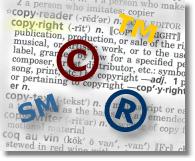|
 Often as an Internet consultant, your clients may call upon you to perform services beyond the scope of just working on their web site. In the course of doing your job, you may be asked your opinion regarding every type of business decision from choosing a company name to whether or not a particular product line should be developed. Offering legal advice, if you are not an expert, is a bad idea. However, should questions about trademarks or copyrights come up, here are some definitions of terms that you can use as a guideline. Often as an Internet consultant, your clients may call upon you to perform services beyond the scope of just working on their web site. In the course of doing your job, you may be asked your opinion regarding every type of business decision from choosing a company name to whether or not a particular product line should be developed. Offering legal advice, if you are not an expert, is a bad idea. However, should questions about trademarks or copyrights come up, here are some definitions of terms that you can use as a guideline.

Copyrights
Definition
Copyright is basically effective upon creation of any literary, artistic, dramatic or musical work or other certain intellectual works. You may claim copyright as soon as your creation is completed by using the © with the necessary information. Use of the © does not necessarily mean you have a registered copyright.
Purpose
The purpose of a copyright is to claim those legal rights pertaining to your own creation of literary, artistic, dramatic or musical material.
What Establishes a Copyright?
The use of © establishes an enforceable copyright. However, registering a copyright with the United Stats Copyright Office can be of value in enforcing copyright actions in court.
How Long Does a Copyright Last?
A copyright lasts for the life of the copyright owner plus 70 years if published after January 1, 1978. There are other issues relating to the life of a copyright. More information on this subject can be found at the US Copyright Office. Visit their web site at www.loc.gov/copyright.
How do I File for a Copyright?
The necessary forms for filing a copyright can be found at www.loc.gov/copyright. A $30.00 fee is required for filing. See their web site for further and more detailed official information.
  
Trademarks
Definition
A trademark is a claim to any logo, sound, color, name, symbol, word, letter, phrase or any combination of these where the owner has claimed legal and exclusive use of the product or service being trademarked by such logo, sound, color, work, letter, phrase or combination and which claim is identified by a mark (™, ®, SM).
Purpose
The purpose of a trademark is primarily to protect intellectual property such as logos, sounds, colors, words, letters, phrases or any combination of these. Once trademark is claimed and registered, legal rights of ownership are enhanced. Claiming trademark has limited legal ramifications whereas registration of a trademark has greater legal ramifications.
What Can be Trademarked?
A logo, sound, color, name, symbol, word, letter, phrase or a combination of these can be trademarked for products and/or services.
What is the Difference Between ™, ®, and SM?
™ is a claim of trademark on a product. This is used prior to receiving registration and refers primarily to products. SM has the same effect as ™, but is used to claim trademark to a service (servicemark). ® identifies a federally registered trademark. Upon receipt of this status, it is no longer necessary nor desirable to use ™ or SM.
How do I Register a Trademark?
The United States Patent and Trademark Office is the key to registering a trademark. You may obtain the necessary forms from them by telephone or at their website http://www.uspto.gov/main/trademarks.htm. You will need to file an application and pay a fee of $325.00. Once you file your application, the USPTO will review your application and conduct a search. you will receive a report from the USPTO which will identify all potential conflicting marks which are either registered or pending registration. Not all of these may be conflicting marks, but the search by the USPTO is very thorough. If there are no conflicting marks or other related issues, your mark will eventually be published in the Official Gazette, a weekly report of approved trademarks. From the first date of publication, a person has 30 days to object to your mark's registration. Provided no person objects, you will receive a Notice of Allowance of your mark. You must respond by filing a Statement of Use with a fee of $100 to officially be registered. Failure to follow these procedures may result in the abandonment of your mark. The initial filing fee is non-refundable for any reason.
What Else Should I Know Before I File?
Research your mark thoroughly prior to applying for registration. You may do this by searching online at the USPTO's database, going to a USPTO depository library and researching records, paying an attorney or trademark research company, or paying the USPTO to conduct the search for you. Having someone who specializes in this type of research perform the search for you will be somewhat costly, but it is worth it in the long-run. The money spent claiming trademark use and losing that trademark to someone receiving registration can be very expensive and frustrating. Look for further and more detailed official information at the USPTO web site.
Disclaimer - These comments are not to be considered the official information on trademarks and copyrights. They are to be understood as guiding information. You should use the information contained herein to do research into the official information published by the federal government and professional trademark and copyright attorneys or other persons.
|

